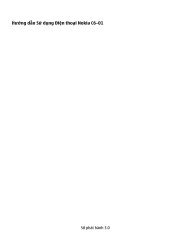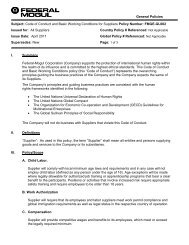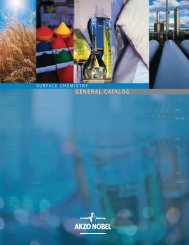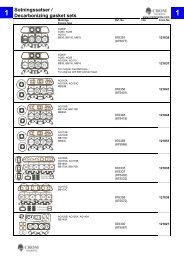You also want an ePaper? Increase the reach of your titles
YUMPU automatically turns print PDFs into web optimized ePapers that Google loves.
SUPER PRECISION<br />
B<br />
INTRODUCTION<br />
<strong>Timken</strong> ® tapered roller bearings have been used <strong>for</strong> many years in<br />
machine tool applications due to their widely recognized advantages<br />
in stiffness, load-carrying capacity, precision and reliability over<br />
other bearing designs.<br />
The use of new ceramic and CBN cutting tools, together with<br />
increased spindle motor powers, has allowed much higher cutting<br />
speeds to be achieved in many applications. To maintain the same<br />
global accuracy level at these higher cutting speeds poses a<br />
challenge to develop optimum spindle designs. <strong>Timken</strong> has met this<br />
challenge by developing:<br />
• Special internal bearing geometry.<br />
• Innovative bearing designs.<br />
Technical in<strong>for</strong>mation is provided in the Engineering Section of<br />
this catalog to assist the designer in selecting the right bearing<br />
arrangement <strong>for</strong> a given application.<br />
Because of their high capability to carry loads together with a<br />
relatively low level of applied loads in the machine tool industry,<br />
precision tapered roller bearings are seldom replaced <strong>for</strong> fatigue<br />
damage. The bearings are mainly replaced when a global loss<br />
of precision of the machine is observed leading to a complete<br />
refurbishment of the machine. At this stage, it is advisable to replace<br />
the bearings, even if they may appear to be in good condition; they<br />
may be worn to a point where the accuracy is no longer effective.<br />
BEARING REPLACEMENT<br />
Even if a machine is considered old after several years of service,<br />
it is not recommended to fit standard class bearings in place of<br />
the original precision ones. This practice would most likely result<br />
in uncontrolled movements of the spindle due to the higher runout<br />
of standard bearings. This can lead to poor accuracy of machined<br />
pieces and premature tool wear.<br />
The best practice is to install a bearing of an equivalent precision<br />
class to the original equipment recommended by the builder.<br />
Both inner and outer rings have to be replaced to achieve the same<br />
accuracy level as the original equipment.<br />
INSPECTION<br />
The replacement of the bearings on any precision equipment is<br />
not necessarily sufficient to restore the original accuracy. If the<br />
surrounding components (spindle, housing, nut, spacer) show<br />
considerable defects in size or <strong>for</strong>m, the bearing will simply transmit<br />
the consecutive default to the workpiece. The total runout of<br />
the system is the combination of the runout of each component.<br />
A precision bearing will add no more runout than is specified by<br />
the bearing class, but it will not reduce any runout already present<br />
from the spindle and housing.<br />
Careful inspection of the adjacent components followed by an<br />
appropriate refurbishment, if needed, must be made be<strong>for</strong>e<br />
remounting the bearings. Particular points to be checked are<br />
geometry (roundness, cylindricity, concentricity), surface conditions<br />
(nicks, burrs), sizes (bore, O.D. and width) and resultant fitting<br />
practice (see Engineering Section).<br />
REMOUNTING<br />
The guidelines described in the Engineering Section apply<br />
exactly in the same way <strong>for</strong> replacement purposes as <strong>for</strong> original<br />
equipment.<br />
PRECISION BEARING TYPES<br />
The most popular tapered roller bearing types made in precision<br />
classes are the single-row bearings, types TS and TSF, and the<br />
two-row bearing, type TDO.<br />
These bearing types are supported by a range of special bearings<br />
that have been designed <strong>for</strong> machine tool applications, such as the<br />
variable preload Hydra-Rib TM bearing, the high-speed TSMA bearing<br />
and the compact TXR crossed roller bearing, which are available<br />
only in precision classes.<br />
The size range of <strong>Timken</strong> precision bearings starts from less than<br />
20.000 mm (0.7874 in.) bore and extends to over 2000.000 mm (78.7402<br />
in.) outside diameter, depending upon bearing type.<br />
The importance of this market segment is demonstrated by <strong>Timken</strong>’s<br />
commitment to having a plant dedicated to producing precision-class<br />
tapered roller bearings. This simply means that the precision quality<br />
is built into the bearing during manufacturing and is not achieved by<br />
selecting from standard bearings. For increased reliability, <strong>Timken</strong><br />
bearings are manufactured from high-quality alloy steels.<br />
110 TIMKEN MACHINE TOOL CATALOG







